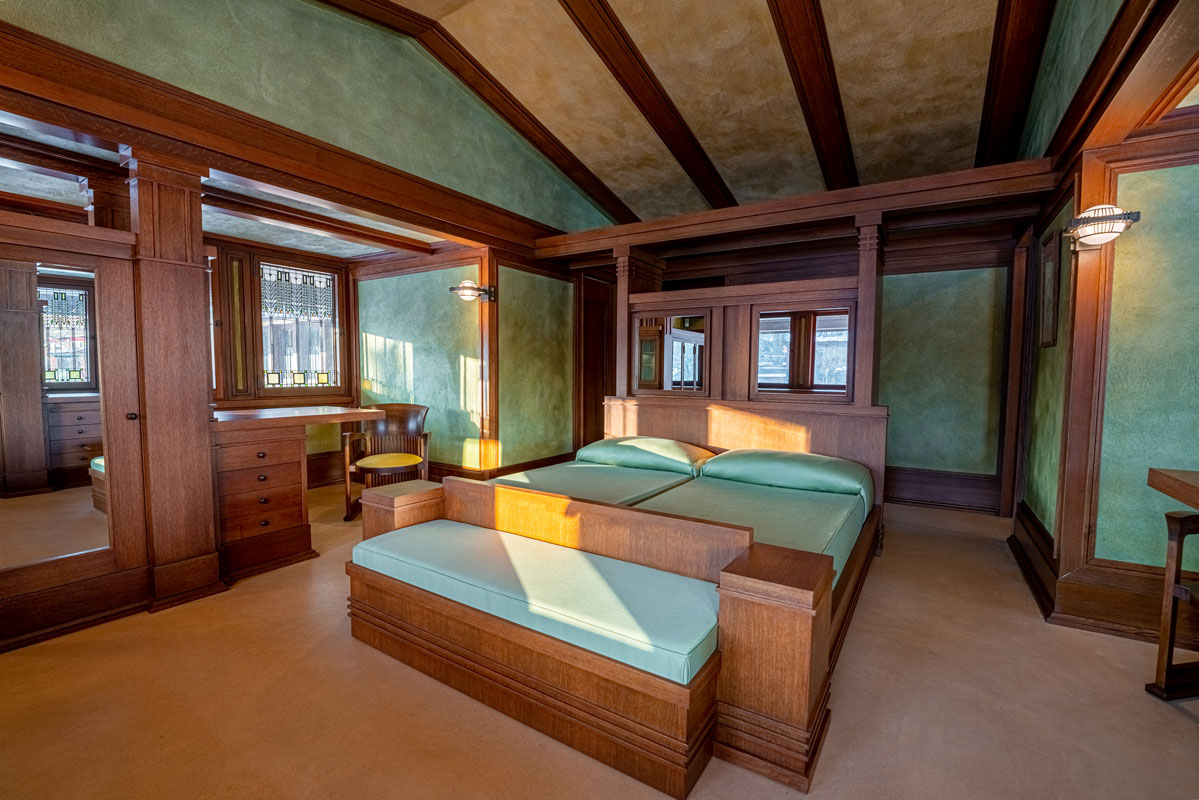This article, written by Mark Sommer, originally appeared in The Buffalo News on July 6, 2021.
Frank Lloyd Wright, considered one of this country’s greatest architects, was known for sometimes overlooking basic comforts in pursuing his artistic vision.
A bed built too short. A bathroom sink mere inches from a bathtub.
The oversights are now evident in the general tour of the Darwin Martin House that for the first time includes the second-floor bedrooms Wright built for the Martin family, guests and servants.
Tours have resumed after the pandemic caused a halt for 15 months.
The master bed unit features twin beds located between a headboard and the back of an upholstered bench seat. Darwin and Isabelle Martin found the beds too short.
“The Martins complained,” said Mary Roberts, the Martin House’s executive director. “I would have, too – they must have thought all this money and we can’t sleep in our beds.”
The house cost $175,000 when it was built at the turn of the 20th century.
“Wright was occasionally wrong but never in doubt,” Roberts laughed.
Darwin Martin was perturbed about the bed’s short length, and he wrote a letter to Wright on Feb. 28, 1906, wanting something done about it.
“Now, why did you made [sic] the beds only 5’10” long?” Martin wrote. “Why did you take the liberty, without consulting us, of cutting out 7” from the length of a normal bed?
“If the bed was only wide enough one might lie diagonally,” he wrote. “Have you any objections to my spending the necessary money to obtain new sides 6’8″ long? Did you ever sleep in a bed too short?”
Wright historian Jack Quinan said Wright designed a pair of twin beds for a later commission that formed a trapezoid, requiring special sheets to be made.
The mercurial architect was aware of what some might consider a flawed approach to his designs, Quinan said. “His standard line was, ‘I’ve been black and blue my whole life from sitting in my own furniture.’ ”
Martin House administrators had been reluctant to include the second floor on the general tour because they wanted to contain the tour time to one hour. The tour begins with an introductory film in the Greatbatch Pavilion, before moving through the house’s first floor and into the conservatory, pergola and carriage house. The second floor now adds 15 minutes to the tour.
Roberts said it became clear the second floor needed to be included in the tour.
“One of the questions most commonly asked has been, if we’re touring the Martin House, do we get to go upstairs?” Roberts said.
The second floor contains eight bedrooms and four bathrooms. Half the space is for family, one-quarter for guests and one-quarter for servants.
The rooms aren’t furnished because Wright didn’t design the furniture used in the rooms, with the exception of the master bedroom.
The wood is rift-sawn white oak, although mahogany can be found inside the guest rooms.
Wright didn’t want to import mahogany since he championed American materials, but he agreed to do so after failing to dissuade the Martins from putting their mahogany furniture in the guest rooms.
The servants area includes a sewing room with tall art-glass windows to let light in and a bathroom, where a child-size bathtub practically abuts the sink.
The second floor, like the rest of the house, has shimmering wall finishes made with glazes of hand-ground metallic pigments mixed with linseed oil and a small amount of heated beeswax.
The colors and finishes were the result of an analysis by a historic paint specialist from Chicago. The original colors – mainly gold, green and soft orange – were identified and recreated.
That came after all the woodwork and plaster were removed in the early 2000s as part of the $52 million reconstruction and restoration project, the largest ever for a Wright property.
The Martin House complex was completed with the planting of Wright’s floricycle landscape in 2019. The property is now a jumble of white geraniums, blue clips bellflower, blue mirror delphinium and weeping forsythias.
The Martin House, a National Historic Landmark, drew over 40,000 visitors in 2019, the highest ever, and 2020 was expected to surpass that. Instead attendance plummeted more than 75%.
“When 2020 shut us down, it really hurt,” Roberts said.
But travelers are returning. Since April, there have been visitors from 42 states.
This past week saw travel writers visit the Martin House from Detroit and Pittsburgh.
“We’re starting to see the interest coming from the media again, too,” Roberts said.
Visit Buffalo Niagara is marketing “The Wright Road Trip” this summer, to encourage people to visit multiple Wright sites in Buffalo and in the Laurel Highlands of Western Pennsylvania, home to Wright’s midcareer masterwork Fallingwater.
Buffalo will also host the Frank Lloyd Wright Building Conservancy’s national conference in October.
The Martin House still requires people to wear masks indoors, but the removal of Covid-19 shields this week in the gift shop is yet another sign that things are continuing to get back to normal.
A variety of tours are now available multiple times a day Wednesdays through Sundays, with discounts for students and seniors. The cost of the basic tour is $22.
Seven large sculptures on the grounds created by Jun Kaneko, along with three on the inside will remain on display through Oct. 17.
For more information on the tours, special events or to view the new 360-degree virtual tour, go to martinhouse.org.









